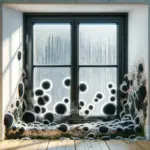Nothing can ruin a home faster than an accumulation of mold. Even if your living space is impeccably clean, it will still contain trace quantities of mold spores that cannot be seen with the naked eye. Though sanitization can help prevent mold growth, it remains part and parcel of nature’s cycle. Causes of mold growth can include excessive moisture from a leaky roof or plumbing, poor ventilation, or humidity levels that are too high. Climate conditions such as high humidity, and flooding or damp basements can provide the perfect environment for mold growth indoors.
Though they fulfill a crucial part in decomposing organic materials, the World Health Organization classifies exposure to mold as a hazardous hazard that can affect the respiratory system.
Therefore, it is essential to initiate decisive action toward finding a solution to this issue. The initial step to safeguarding your home against mold is understanding what leads to its growth. It’s critical to be aware of the potential consequences of allowing a small patch of mold to grow into an extensive and costly issue.
Where is Mold most likely to Grow:
Roof
A common cause where mold can be found in your home is a roof leak. It’s important to regularly inspect your roof for damage and make any necessary repairs as soon as possible. Allowing water to remain stagnant in your home can lead to the rapid germination of mold spores, as the moisture and organic matter present create an ideal environment for its growth.
If you notice water dripping from the ceiling tiles or wet spots on the walls, this could be a sign that you have a leaky roof that needs to be addressed.
When a roof is leaking, two types of mold growth can occur: systemic or limited. Systemic growth is a result of moisture build-up due to roof leaks, which can lead to the rapid spread of mold throughout an entire area.
When this occurs, moisture accumulates due to an indirect source. Without a controlled level of moisture and proper ventilation created by a leaky roof can stunt growth in any given space. To best address the leak concentrates your efforts on its immediate vicinity.
Walls
Also, common causes for mold growth, are damaged and broken walls as moisture can easily seep into areas with poor protection and permit moisture to permeate, resulting in a damp surface that with time may foster mold growth. Before attempting to remediate any dampness in your walls, be sure to pinpoint its source first. Identifying the origin of moisture will help you find an effective solution more quickly.
Pipes
Another common cause of mold growth is a leaky pipe. A leaking pipe could be to blame if you notice puddles in your basement or any other part of your home. You will want to immediately address the issue and repair any damaged plumbing so that the water can properly drain out of your pipes.
Leaking pipes can have far-reaching and disastrous consequences in any home, ranging from the mild inconvenience of water damage to the severe threat of mold growth. This is an immense problem since the mold tends to proliferate and can be challenging to get rid of. Before it spreads, invest in a professional solution that will halt mold growth and protect your other areas.
Basement
An in-ground basement provides a perfect environment for mold to grow and thrive. Basements offer a perfect environment for mold growth, with dark and warm conditions, little ventilation, and high humidity. Plus, there are plenty of food sources and oxygen to sustain the organisms.
Preventing mold from basements is not an easy task, but there are a few things that you can do to reduce the likelihood of mold growth in your home.
The first step is to ensure that your basement has adequate ventilation. Keep the area as dry and cool as possible by installing fans and dehumidifiers and making sure there are no holes or cracks in the walls where moisture can reenter.
Crawl spaces
In contrast to a traditional basement, some homes are built with crawl spaces. Cost-efficient and suitable for moist areas, vulnerable to moisture accumulation and mold build-up. The presence of mold in crawl spaces is an alarming indicator that requires immediate attention. This indicates that there is an issue of greater magnitude occurring upstairs.
Bathroom
The bathroom is the most common room to find mold and the easiest to spot and identify. If you notice black mold in your shower, this can indicate a larger issue with the ventilation in your home. Bathrooms are breeding grounds for mold, given the many surfaces which create an ideal environment. Areas like smooth tile faces and grout spaces are often prone to mold growth if the moisture level isn’t regulated. An ideal environment for mold to breed and flourish is inside vanity cabinets and behind toilets where airflow is hindered.
You can efficiently prevent mold growth and its potential spread by taking proactive steps to seal off any areas of your bathroom that are exposed to moisture and improving ventilation.
Kitchen
When it comes to plumbing, kitchens come only second to bathrooms in terms of the amount of water contained in their components. Not to mention water supply lines, drain pipes, sinks, dishwashers, and ice makers. Leaks can come from the dishwasher and sink supply and drain lines, faucets, and other components.
One common cause of mold in kitchens is leaking from the plumbing system. A leaky pipe, a cracked drain line, or a damaged water heater can all be moisture sources promoting mold growth. If you notice any leaking pipes or puddles in your kitchen, it is essential to repair the issue as soon as possible to prevent mold from growing and spreading.
Foundation
If you notice that your home shows signs of excessive moisture or dampness, it’s essential to address the issue immediately. A foundation leak could be contributing to mold growth and causing damage to your property, so it’s crucial to have it repaired as soon as possible.
Testing for mold can help identify the causes and extent of the problem, so it’s always a good idea to enlist the help of a professional mold inspector. Whether you’re dealing with a small patch of mold or an entire infestation, effective treatments can eliminate the mold and prevent it from returning.
Heating, Ventilation, and Air-Conditioning (HVAC) System
Mold can be found on the HVAC system in your home, mainly if you are located in a humid climate. The system works to regulate the temperature and humidity of the air in your home by circulating air throughout different areas. Using ductwork, most heating and air conditioning systems are designed to circulate warm air and disperse cool air throughout a space.
These ducts present an ideal environment for mold growth, as they are dimly lit and retain heat, have plenty of air circulation, and maintain the perfect humidity levels. Ductwork acts as a filter, trapping airborne particles and other debris that can vary from the dust present in homes to pet hair and dander. Trapped material not only holds in moisture but also encourages mold growth.
Exterior Mold
In addition to the causes of mold in your home’s interior spaces, several factors can contribute to outdoor mold growth in your house. Exposure to moisture and poor ventilation are two primary causes of exterior mold growth, as they provide ideal conditions for mold spores to grow. Everywhere you look, mold spores have access to the ideal conditions for growth, from suitable temperatures and oxygen levels to light exposure and food sources. Not forgetting an essential factor: moisture.
Many common causes of exterior mold include poor drainage from downspouts, poor ventilation around windows and doors, and excessive moisture due to landscaping or gardening. If you notice any signs of mold on the outside of your home, it’s essential to take action to address these causes and prevent further damage.
Overall, several common causes of mold growth can often be easily missed or dismissed. To protect your home from harmful mold growth, it is important to stay vigilant and be aware of potential causes in all areas of your house. Whether it is a leaky pipe, a damp basement, or an unventilated bathroom, taking action to address the causes of mold can help prevent future issues and keep your home safe and healthy.
If you notice any signs of mold in your home, it’s important to take immediate action and seek professional help to prevent further damage and ensure a healthy living environment. With the right care and attention, you can keep your home free.
What is the difference between Mold and Mildew
Mold and mildew are types of fungi that can grow in damp environments like your home. In addition, they each possess remarkable distinctions in terms of size, color and texture. Unlike plants, which need sunlight to survive, mold and mildew thrive in dark in humid conditions.
Mildew typically manifests as gray or white patches and flourishes in damp environments. Eliminating mildew is an easy process with a commercial cleaner and brush.
In contrast, mold is typically either black or green and usually signals a more extensive issue. This particular type of fungus has a distinct “fuzzy,” primarily when it is found on food items. In addition, some versions can also be slimy and manifest in different colors, such as orange, green, black, brown, pink, or purple.
While some types of mold can be harmful to your health and cause respiratory issues or allergic reactions, most are harmless and easily managed with simple prevention measures like keeping your home dry, repairing any leaks or cracks, and ventilating your home properly.
Mold Spores
Mold spores are the microscopic reproductive structures of mold. They can be found in both indoor and outdoor environments and are a common cause of allergies and respiratory issues. Mold spores can be difficult to prevent or remove, as they are tiny and easily airborne.
Mold Growth
Mold growth is the term used to describe the rapid spread and reproduction of mold spores. This can occur in any environment, from outdoor spaces to your home, and can be caused by a variety of factors, including excess moisture, poor ventilation, and a moist environment.
How can mold affect our health?
Mold is a health hazard and can have a wide range of effects, depending on the type of mold and the sensitivity of an individual. For example, some people may experience respiratory problems or allergic reactions when exposed to certain types of mold. In more severe cases, mold exposure can cause serious health issues such as lung infections, brain damage, organ failure, and even death.
Breathing problems
As dangerous mold spreads, its spores, cells, fragments, and toxic organic compounds are released into the air. Not only can they create allergens, irritants, and mycotoxins, but these contaminants have the potential to drastically affect your health, especially for people who are sensitive to them.
Moreover, moisture causes the decomposition of materials, resulting in higher levels of airborne particles.
Inhaling these particles can cause irritation and discomfort in the lungs, nose, and throat of those already suffering from respiratory issues such as asthma or chronic lung disease.
Airborne mold spores can also trigger asthma attacks in people who already have this condition.
If you suspect that you or your family may be experiencing the effects of mold exposure, seeking medical attention and taking steps to remove the mold from your home is essential. This can include using commercial cleaners and dehumidifiers, as well as adequately ventilating.
Allergies
An allergic reaction to mold can create symptoms that are similar to other seasonal allergies, such as hay fever. In many of these cases, airborne particles significantly affect the upper respiratory tract.
The more dust there is, the greater the likelihood of an invasion of dust mites, which can cause allergic reactions in certain people.
Other conditions
Mold can produce many microbes and bacteria, but exposure to these hazardous contaminants may provoke an inflammatory reaction. For some individuals, mold and its microbial agents may increase the risk of bronchial and fungal infections. Those afflicted with hypersensitivity pneumonitis, bronchitis, allergic alveolitis, chronic rhinosinusitis and/or allergic fungal sinusitis have arguably one of the toughest medical conditions to combat.
Higher levels of dust can lead to an increase in the presence of dust mites, which may also cause allergic reactions in specific individuals.
However, most mold is relatively harmless and can be managed with simple prevention measures like limiting water damage in your home, maintaining good air quality, and fixing any leaks or cracks immediately. To reduce the risk of developing health issues due to mold exposure, it is important to keep your home clean, dry, and well-ventilated. However, a rare and highly toxic black mold called Stachybotrys chartarum can be dangerous in some cases. This toxic mold presents itself as a cluster of dark green to pitch-black spots. If your mold colony looks like that, make sure you take personal precautions in handling this pathogen.
If you have any concerns about mold in your home, be sure to talk to a healthcare professional or take steps to remove the mold as soon as possible.
How to Prevent Mold Growth
To effectively manage mold growth in your home, it is important first to understand what causes it and how to prevent it. Some common causes of mold include moisture from flooding or leaky roofs or pipes, poor ventilation, high humidity levels, and indoor mold growth.
To prevent mold, it is important to keep your home dry, well-ventilated, and free of leaks or cracks. You can also use dehumidifiers and air filters in your home to manage moisture levels and reduce the risk of mold growth. Additionally, you should regularly clean surfaces in your home that may be prone to mold growth, such as walls, floors, windows, and HVAC systems.
If you do have a mold problem in your home, it is important to take action immediately. You can remove small patches of mold by cleaning the affected area with detergent and water or a commercial mold cleaner. If the mold has spread more extensively or appears to be growing in areas you cannot easily reach, it may be best to hire a professional mold remediation team to help.
Overall, the key to managing and preventing mold growth is taking action as soon as possible and following a few simple steps to keep your home clean, dry, and well-ventilated. With proper care and attention, you can reduce the risk of mold and keep your home healthy and safe.
If you are concerned about potential mold exposure, it is important to talk to a doctor or healthcare provider for advice on how best to protect your health. You may also want to consider consulting with a mold remediation specialist to help address any mold issues in your home and prevent further exposure. By taking the proper steps to prevent, manage, and treat mold, you can help keep your family safe and healthy
Mold Remediation
Many different methods can be used to remove mold from your home. These include cleaning the mold with detergent and water, using commercial mold cleaners or disinfectants, or hiring a professional mold remediation team to help assess and treat the problem. It is important to take action as soon as possible if you suspect that there may be mold in your home, as exposure to this hazardous substance can have serious health effects. To prevent and manage mold growth, it is important to keep your home clean and dry, fix any leaks or cracks immediately, and take other necessary steps to maintain good air quality. Proper care and attention can help remove mold from your home and protect your family from associated health risks.
Mold Testing
If you are concerned about mold exposure in your home, it is important to consider getting a mold test to determine whether mold is present and what types of mold may be growing. Several methods exist for testing mold, including air sampling, surface sampling, and bulk sampling.
Air samples involve using an air pump to draw air through a collection device, while surface sampling involves taking small samples of mold growth from different locations in your home. Bulk sampling is typically done using a swab or scraping tool to collect a sample directly from the source of mold growth.
Once you have collected your mold samples, you will need to send them to a lab for testing. The results of your mold test can provide important information about how best to treat any existing mold growth in your home and prevent future issues.
If you think you may be experiencing health problems related to mold exposure, it is important to seek medical attention from a qualified healthcare provider. They can help determine the cause of your symptoms and advise on steps to take to protect your health going forward. Additionally, if you have any concerns about mold in your home, it may be helpful to consult with a professional mold remediation specialist who can help address the issue and keep your family safe.
[/et_pb_text][/et_pb_column][/et_pb_row][/et_pb_section]


